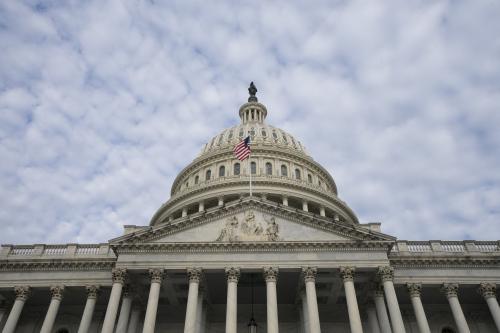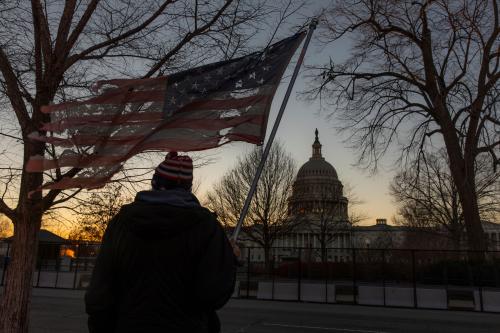Democracy has been under increasing assault in the U.S. over the course of this century. Sixty percent of white working class Americans agreed with the statement that “because things have gotten so far off track in this country, we need a leader who is willing to break some rules if that’s what it takes to set things right.” Although only 40% of all Americans felt that way in 2017, almost 47% of them voted in 2020 to support a candidate for president who exhibited blatant authoritarian behavior. For the first time since the 1930’s, the competition between democracy and autocracy to determine how we will be governed in the future is in doubt.
The view that this authoritarian threat can be defused by converting those who would abandon the Constitution “to get things done” through persuasion and empathy is contradicted by both social science and electoral fact. Study after study has documented that efforts to change political opinions through rational argument and the deployment of fact changes few minds and often hardens opinions instead. Nearly one hundred court rulings and the certification of the 2020 election results by all 50 states still leaves 77% of Republicans questioning the legitimacy of President Biden’s election based on supposed voter fraud. If there are words, facts, or empathy that can change those views, no credible evidence to support the strategy has been presented.
A more hopeful strategy can be found in the contest between the U.S. and the Soviet Union after World War II. In his now famous “X article” in the July 1947 issue of Foreign Affairs, U.S. diplomat George Kennan publicly proposed defending democracy using a strategy of “containment.” Rather than aggressively pushing to overthrow the Soviet Union or believing that the Stalinist regime could be “charmed or talked out of existence,” Kennan argued that an authoritarian Soviet Union “be contained by the adroit and vigilant application of counter-force at a series of constantly shifting geographical and political points.” The foundation of his proposal was the belief that the contradictions inherent in Soviet party rule would ultimately lead to collapse of the system or at least its considerable mellowing if denied opportunities for expansion.
Employing containment rather than conversion as a strategy for preventing the development of authoritarian governance here at home offers a series of powerful advantages:
- Those proposing autocracy over democracy remain a minority. Over sixty percent of Americans believe the 2020 presidential election was fair. Containment does not rely on changing the political opinions of millions of Americans, a proposition which ought to be pursued, but for which no credible action plan exists. Defense of democracy doesn’t require converts, only holding the line.
- In the present day, the foundation that supports a domestic containment strategy is more concrete than Kennan’s speculative assertion that the Soviet Union would inevitably collapse under its own contradictions. It rests on the existing political and cultural views of the rising electoral generations of Millennials (Gen Y), born in the last two decades of the 20th century and Plurals (Gen Z), born in the first two decades of this century.
Demographics are not an “invisible hand” insuring the victory of liberal democracy over autocracy. However, on the research-based assumption that current cultural and civic generational views are usually an indicator of a generation’s future outlook, the polled opinions of our two newest generations provide some long-term optimism.
We start with the view that fears of white displacement and of new cultural values that are undermining the perceived essence of “Americanism,” not economics, are the major drivers of those most willing to work outside inherited constitutional rules and norms. Anxiety and anger over the coming loss of a white majority are reflected in opinions about racial diversity that vary widely by generation. Sixty-two percent of Plurals and 61% of Millennials think that increasing racial and ethnic diversity is good for America, compared to 48% of Boomers and 41% of the even older Silent generation. Plural Republicans are also much more likely than their older GOP counterparts to agree with this statement.
Similar generational gaps exist on the issue of whether immigrants are a benefit or burden to the country with 75% of Millennials saying they are a benefit compared to 52% of Boomers and 44% of Silents. A majority (53%) of both younger generations believe that “people of different races marrying each other” is a good thing as opposed to 30% of Boomers and 20% of Silents—further evidence that the ascending electorate is hardly afraid of the pollution of white culture and blood by “others.”
While it is not always true that as the generational “twig is bent, the tree’s inclined”, the attitudes towards race of America’s two youngest generations offer hope that time may be on our side in pursuing a containment strategy.
A containment action agenda
A domestic containment strategy offers a number of actions that those who want to defend democracy can take now, without having to wait for demographics to defeat domestic authoritarianism.
On the defensive front:
- While respecting everyone’s constitutional rights, the minority must not be allowed to overrule the expressed will of the majority. Securing majority governance and blocking authoritarian minorities from taking federal power requires minimizing gerrymandering; eliminating voter suppression; reforming, if not eliminating, the Senate’s filibuster rule; and making campaign financing as transparent as possible.
- Social media algorithms need to be reshaped or at least accompanied by “middleware” as part of reforms to Section 230 of the Communications Decency Act of 1996. This will help social media consumers assess the reliability of the source of what they are seeing and encourage exposure to differing points of view. Further experiments with independent governance structures for determining the acceptability of political content on social media platforms, similar to the one Facebook has deployed, should also be encouraged.
- A clear line must be drawn between violence and peaceful protests. Law enforcement must deal vigorously and visibly with the threat of violence from that element of the authoritarian minority that is prepared to use force to pursue its political objectives. As profiles of some of those charged with insurrection on January 6 reveal, nearly ninety percent were not tied to extremist groups and were difficult to distinguish from your next-door neighbor. Prosecution and imprisonment of those who would turn to violence, whether a Proud Boy or the pharmacist down the street will be critical to deterring attempts at political change outside the rules of democratic governance.
Containment also requires sustained and continuous push back against authoritarian views, just as Kennan argued in his memo on containing communism. While waiting for more democratically-inclined generations to seize the electoral stage:
- Lies and distortions of reality must be responded to vigorously and persistently. The election was not stolen, immigration advocates are not motivated by white replacement, whites are not subject to more discrimination than blacks. All those in the public eye, including commentators as well as elected officials, must be held to account whenever they spread such falsehoods.
- Institutions as effective as the National Democratic Institute has been in spreading the idea of democracy worldwide must be created to increase young Americans faith in democracy here at home. While most young people have no sympathy for authoritarian views, they are far from convinced that constitutional democracy is the best form of governance to make the societal changes they seek based on what they have experienced in their lifetime. Above all we must demonstrate democracy works, since gridlocked governing will undermine faith in our democratic system no matter what else we do.
Containment offers a realistic strategy for preventing an authoritarian minority from taking power electorally or extralegally. It buys time until those generations with stronger ties to democratic values assume majority power and protects our democracy until they do. Finally, it allows the champions of democracy—conservative and liberal, Democrat and Republican–to act forcefully together without depending on changing the views of others to prevail. That the strategy worked to win the Cold War is no guarantee that it will work in our domestic struggle with authoritarianism. But it offers the most realistic option before us for winning this war.









Commentary
Protecting democracy and containing autocracy
May 10, 2021